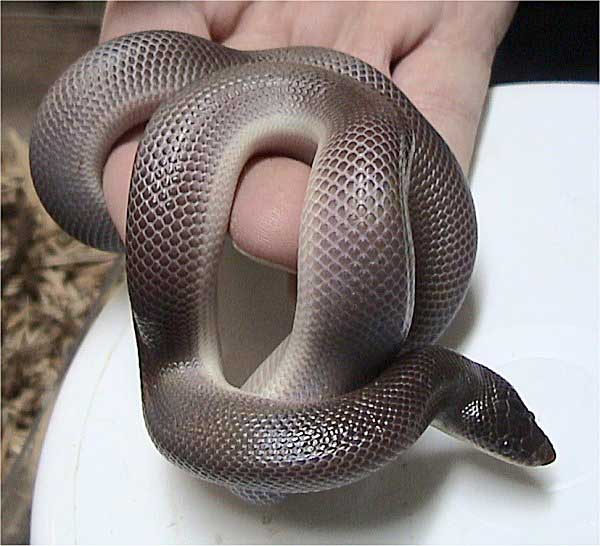
Loxocemus bicolor (*)
Superregnum: Eukaryota
Cladus: Unikonta
Cladus: Opisthokonta
Cladus: Holozoa
Regnum: Animalia
Subregnum: Eumetazoa
Cladus: Bilateria
Cladus: Nephrozoa
Superphylum: Deuterostomia
Phylum: Chordata
Subphylum: Vertebrata
Infraphylum: Gnathostomata
Megaclassis: Osteichthyes
Cladus: Sarcopterygii
Cladus: Rhipidistia
Cladus: Tetrapodomorpha
Cladus: Eotetrapodiformes
Cladus: Elpistostegalia
Superclassis: Tetrapoda
Cladus: Reptiliomorpha
Cladus: Amniota
Classis: Reptilia
Cladus: Eureptilia
Cladus: Romeriida
Subclassis: Diapsida
Cladus: Sauria
Infraclassis: Lepidosauromorpha
Superordo: Lepidosauria
Ordo: Squamata
Subordo: Serpentes
Superfamilia: Booidea
Familia: Loxocemidae
Genus: Loxocemus
Species: Loxocemus bicolor
Name
Loxocemus bicolor Cope, 1861: 77
Holotype: USNM 4948.
Type locality: “La Union, El Salvador.”
References
Primary references
Cope, E.D. 1861. Remarks on Reptiles (Diphalus; Amphisbaena angustifrons; Loxocemus Cope). Proceedings of the Academy of Natural Sciences of Philadelphia 13: 75–77. BHL Reference page.
Links
Uetz, P. & Hallermann, J. 2022. Loxocemus bicolor. The Reptile Database. Accessed on 23 May 2018.
Chaves, G., Lamar, W., Porras, L.W., Sunyer, J. & Solórzano, A. 2014. IUCN: Loxocemus bicolor (Least Concern). The IUCN Red List of Threatened Species 2014: e.T169678A1280046. DOI: 10.2305/IUCN.UK.2014-1.RLTS.T169678A1280046.en
Vernacular names
Deutsch: Spitzkopfpython
English: Mexican Burrowing Python
Nederlands: Spitskoppython
norsk: Spisshodepyton
Loxocemus bicolor,[4] sole member of the monotypic family Loxocemidae,[2] is a species of python-like snake found in Mexico and Central America. No subspecies are currently recognized.[5] Analyses of DNA show that Loxocemus is most closely related to the true pythons and the sunbeam snakes.[6][7]
Description
Adults grow to a maximum of 1.57 m (62 in) in length.[8] On average this snake grows to roughly 91 cm (2.99 ft). The body is stout and very muscular. The snout is shovel-shaped, with a narrow head and small eyes to facilitate burrowing. The species is described as terrestrial and semi-fossorial,[8] which makes them hard to observe and study. The color pattern is usually dark with patches of white scales, although occasionally after shedding all pigment will disappear, resulting in a white snake with only a small dark patch on its head.
Distribution and habitat
It is found along the Mexican Pacific versant at low to moderate elevations in the states of Nayarit, Jalisco, Colima, Michoacán, Morelos, Guerrero, Oaxaca, and Chiapas. From there, its range extends south through Guatemala, Honduras, El Salvador, Nicaragua, and Costa Rica. The type locality given is "La Unión, San Salvador" (in El Salvador).[1]
Lifecycle
They are found in a variety of habitats, including tropical, moist, and dry forests. In Honduras and Guatemala, they also occur in dry inland valleys that drain into the Caribbean.[1] Their diet is believed to consist of rodents and lizards. They have also been observed eating iguana eggs. They are oviparous, laying small clutches of two to four eggs.[8]
References
McDiarmid RW, Campbell JA, Touré T. 1999. Snake Species of the World: A Taxonomic and Geographic Reference, vol. 1. Herpetologists' League. 511 pp. ISBN 1-893777-00-6 (series). ISBN 1-893777-01-4 (volume).
"Loxocemidae". Integrated Taxonomic Information System. Retrieved 17 August 2007.
Species Loxocemus bicolor at The Reptile Database. Accessed 17 August 2007.
"Loxocemus". Integrated Taxonomic Information System. Retrieved 17 August 2007.
"Loxocemus bicolor". Integrated Taxonomic Information System. Retrieved 17 August 2007.
Reynolds, RG; Niemiller, ML; Revell, LJ (2014). "Toward a Tree-of-Life for the boas and pythons: multilocus species-level phylogeny with unprecedented taxon sampling" (PDF). Molecular Phylogenetics and Evolution. 71: 201–213. doi:10.1016/j.ympev.2013.11.011. PMID 24315866. Archived from the original (PDF) on 2015-12-02. Retrieved 2018-05-14.
Pyron, R. A.; Reynolds, R. G.; Burbrink, F. T. (2014). "A Taxonomic Revision of Boas (Serpentes: Boidae)" (PDF). Zootaxa. 3846: 249–260. doi:10.11646/zootaxa.3846.2.5.
Loxocemidae at the Reptarium.cz Reptile Database. Accessed 3 November 2008.
Further reading
Noonan, B. P.; Chippindale, P. T. (2006). "Dispersal and vicariance: The complex evolutionary history of boid snakes". Molecular Phylogenetics and Evolution. 40: 347–358. doi:10.1016/j.ympev.2006.03.010. PMID 16624591.
Mattison, Chris (1999). Snake. DK Publishing. ISBN 0-7894-4660-X.
Retrieved from "http://en.wikipedia.org/"
All text is available under the terms of the GNU Free Documentation License

